Virginia
-
- Insights: Outgoing Transportation Sec. Connaughton Marine News, Feb 2014 #12
Outgoing Secretary of Transportation for the Commonwealth of Virginia
Until January of this year, Sean Connaughton oversaw seven state agencies with more than 9,700 employees and combined annual budgets of $5 billion. Connaughton is probably better known to MarineNews readers as the U.S. Department of Transportation’s Maritime Administrator during the second Bush Administration. As U.S. Maritime Administrator, he was responsible for the daily management of that agency and its promotional programs for the marine transportation industry. This included advising and assisting the Secretary of Transportation on commercial maritime matters, operation of over 50 ships in the Ready Reserve Force, supervision of the U.S. Merchant Marine Academy, oversight of the six State Maritime Academies, and administration of various shipyard and cargo programs. Along the way, he also served as Corporate Vice President, Government Affairs for the American Bureau of Shipping. Connaughton is a graduate of the U.S. Merchant Marine Academy and served the U.S. Coast Guard as both a commissioned officer and as a civil servant in the Office of Marine Safety, Security, and Environmental Protection. After gaining a Master’s degree from Georgetown University, he joined the American Petroleum Institute, representing companies involved in the energy and marine transportation industries, during which time he also earned a law degree from George Mason University. His many honors include the 2009 Vincent T. Hirsh Maritime Award for Outstanding Leadership by the Navy League of the United States and an honorary doctorate in Public Administration from the Massachusetts Maritime Academy. As his tenure ended in the Commonwealth of Virginia, we caught up with him and sought his reflections on not only the past four years, but also his take on the collective domestic waterfront. Arguably, there are few marine professionals better equipped to give that “SITREP.”
As you end your four-year tenure as Secretary of Transportation for the Commonwealth of Virginia, let’s look back at the highlights of that time, especially from the standpoint of intermodal progress and the waterfront. What are the biggest ‘take-aways’ for you after your experience in Virginia? What could Washington learn from Virginia?
Transportation is a tough business at the state level; it is literally where the rubber hits the road. You face competing interests, politics, limited resources and the ever present federal bureaucracy. However, you can get a lot done if you stay focused and find ways around the roadblocks. We have done that in Virginia over the past four years and our program is now regarded as one of the best in the nation. The biggest disappointment has been the federal role. Four years ago, the federal highway transfer was about one-fourth of the state’s transportation funding, now it’s one fifth and in just three years from now it will be one-sixth. That drop will be even more dramatic if Washington does not address its funding problem, as we did in Virginia. In addition to funding concerns, onerous federal rules and regulations hinder sound transportation planning and discourage transportation investment. Incredibly, it seems that the federal constraints are increasing at the same time that their financial commitment going down. It is hurting jobs, the economy, and American competitiveness. Something has to change.
What was your proudest moment in Richmond?
I have had a great tenure as Secretary and can point to much that we accomplished, but the proudest moment was the passage last year of the first comprehensive transportation funding legislation in 27 years. The need for more funding for transportation has been recognized in Virginia for a long time but getting it actually done has been a goal for the last four Governors. As passed, the legislation provides billions more every year for all modes of transportation as well as moving Virginia away from reliance on the declining gas tax. The legislation came after a herculean effort by our Administration that included years of trying every idea and trick to advance transportation projects, including public private partnerships, bond sales, administrative audits, reducing personnel and promoting sponsorships. Virginia’s legislation is precedent setting and considered a model for other states and the federal government.
One aspect of what sets you apart from other maritime professionals – in our mind – is your attention to the entire intermodal equation and not just the waterfront itself. They all come together. Talk about the development of your inland ‘ports’ and FTZ areas at, for example, Front Royal, Richmond and other places.
As Secretary, I oversaw Virginia’s road, rail, transit, aviation, maritime, motor vehicle regulation, and commercial space programs. It is interesting that some people were puzzled when a perceived “maritime guy” was appointed to a job dominated by road and transit challenges. Virginia not only has a major seaport, but approximately one third of its economy and jobs are in sectors dependent on a well-functioning transportation system, such as agriculture, mining, logistics and manufacturing. We look for ways to make transportation investments that stimulate economic growth. The Virginia Inland Port, which connects the Shenandoah Valley to the Port of Virginia via rail, has created thousands of jobs and billions of investment in the areas surrounding it. We look to replicate that success at the Port of Richmond with the I-64 barge service. We have also funded another inland port in southwest Virginia as well. We have developed a freight transportation plan that looks at how we can invest in order to move freight via road, rails, water, and air more efficiently. And, we are using that plan to make investments that relieve congestion as well as improve Virginia’s competitiveness.
Sum up the state of the I-64 barge express on the James River between Hampton Roads and Richmond. How many trucks have you taken off the road? Is the concept picking up steam – and more importantly, cargo volume?
The service has been a success. We invested in the I-64 barge service with the intention of keeping trucks off I-64. One of the biggest traffic problems we have in Southeastern Virginia is the congestion on I-64, which is the primary highway route connecting the Hampton Roads region to the rest of the state. The interstate itself, and specifically the two bridge tunnels on this interstate, are reaching capacity. Even though rail movements are important to our port, two-thirds of the containers it handles continue to move by truck. Virginia has committed billions to expand its port and improving the supporting highway system, but more needs to be done. The number of marine containers moved by barge is now around 5% and we intend to keep growing that volume. We are also interested in partnering with other ports to initiate services that can keep trucks off of I-95 as well.
You’ve advocated for the waterfront on a national and state level for many years. What’s the state of America’s maritime industry as we launch into 2014? We are in the midst of as robust a ship / boatbuilding boom as the nation has arguably seen in four decades. It’s all good; some of it fueled by the shale boom and the rest, a revived offshore production environment. What can we do to keep it going beyond the usual cyclical up s and downs?
The normal cycle of the U.S. maritime industry seems to be one in which one sector booms while others bust. The problem is that these cycles hide a continual state of decline. The maritime industry is critical to the American economy and national defense and the nation needs to develop and implement a national strategy that improves its health and competitiveness. The federal government seems to have little trouble “saving” industries such as banking and auto manufacturing, so there are few valid arguments why it cannot turn its attention to the maritime industry. Given the growth in global trade and the need for domestic transportation alternatives along with great job opportunities, the maritime industry is the type of cutting edge 21st Century industry that the United States needs to play a significant role. The challenge is getting the Washington to wake up before it is too late.
Sum up what our national transportation strategy should be in the come year. Five years? Ten?
The nation’s current transportation “strategy” seems to be about convenience, not competitiveness. People forget that the federal government was originally formed to address interstate and foreign commerce challenges and some of the first federal programs dealt with transportation, such as lighthouses and shipping. Today, the focus is mostly on urban mobility and, as a result, the federal program has become mired in local minutia instead of the global transportation and economic needs of the nation. The federal government should step back from its current micromanaging of transportation, focus on freight and the projects that enhance economic growth, give States and localities greater flexibility in allocating funds, eliminate the red tape that adds little beyond time and expense to the process, and develop a national gateway and investment plan.Wind Power: 2014 brings us seemingly closer than ever to this so-far unrealized maritime, offshore industry here in the United States. Virginia is in the mix, as well as Massachusetts, Rhode Island and others. Where does it look most likely to finally happen – and more importantly why or why not?
The challenge offshore wind energy faces today is the same challenge we seem to face in every sector of infrastructure: federal rhetoric versus reality. Washington policymakers publicly state their support for renewable and alternative energy but at the same time they have done little to address the regulatory and legal hurdles that have stalled these projects. Offshore wind energy is good for both maritime jobs and diversifying America’s energy future. However, this industry will not reach its full potential until the federal government can assure project developers that their investment will actually result in wind farm construction and operation.
After high profile tenures as U.S. Maritime Administrator and Secretary of Transportation for the Commonwealth, what’s next for Sean Connaughton?
I have not decided yet. I have had a great run over the past 15 years in leadership positions at the local, state and federal levels of government, but it is definitely time to return to the private sector. I will be making a final decision in the coming weeks.
(As published in the February 2014 edition of Marine News - www.marinelink.com)
-
- Logistics and Warehouse Insurance: Understanding its Complexity Maritime Reporter, Apr 2015 #28
or operational exposures and manage the complexity that comes with moving and storing goods that are a vital part of supply chains. The Author Virginia Cameron is Senior Vice President of Inland and Ocean Marine in XL Group’s North America Marine business where she oversees strategy, underwriting
-
- INSIGHTS: John F. Reinhart, CEO, Virginia Port Authority (VPA) Maritime Logistics Professional, May/Jun 2019 #10
John F. Reinhart is the CEO and executive director of the Virginia Port Authority (VPA). He is responsible for the broad programmatic areas of business development and growth, strategic marketing, finance, and operations of Virginia’s marine terminal facilities: Virginia International Gateway, Newport News
-
- Propeller Symposium Slated For May 1978 At Virginia Beach, Va. Maritime Reporter, Mar 1978 #10
A technical s y m p o s i um on ships' propellers will be held on May 24 and 25, 1978, at the Cavalier Hotel, Virginia Beach, Va. Entitled "Propellers '78," the symposium is to be jointly sponsored by Technical and Research Panel M-16 (Modernization of Propulsion Shaft Systems) and the Hampton
-
- AAPA Moves Headquarters To Arlington, Virginia Maritime Reporter, Oct 1984 #6
After 35 years of operations in downtown Washington, D.C., the American Association of Port Authorities has relocated its headquarters to Alexandria, Va., a port city located directly across the Potomac River from the nation's capital. The 6,000-square-foot office building is a part of the new
-
- Propellers '84 Scheduled For May 15-16 At Cavalier Hotel In Virginia Beach Maritime Reporter, Apr 1984 #64
have been attracting wide attention in the marine engineering community for the past decade will be presented on May 15-16 at the Cavalier Hotel in Virginia Beach, Va. Titled Propellers '84, the meeting is being organized by the Technical and Research Program of The Society of Naval Architects and
-
- Gladding-Hearn Delivers Two Launches To Virginia Pilots Maritime Reporter, Dec 15, 1983 #34
what line of business you're in, prompt and responsive service to your clients is an absolute essential. No one recognizes this fact more than the Virginia Pilots Association of Norfolk, an organization that is continually looking for ways to improve its operations and better serve the ships that call
-
- Propose Plans For $230 Million Coal Export Terminal In Virginia Maritime Reporter, Sep 1981 #7
of 10,000 tons per hour. A feasibility study of a new coal export terminal on the south side of Hampton Roads is currently being undertaken by the Virginia Port Authority, a state agency. The study is comparing three possible locations for a new terminal in the cities of Portsmouth, Suffolk and Chesapeake
-
- Friedmann Will Head New Eclectech Office In Virginia Beach Maritime Reporter, Nov 1980 #72
Eclectech Associates, a subsidiary of Ship Analytics, has opened an office in Virginia Beach, Va., at 2697 International Parkway. The office is headed by Rod Friedj mann. The Virginia Beach office will serve as a contract development and support center for Eclectech's military, merchant marine
-
- US Navy: Bigger is Better, but at What Cost? Maritime Reporter, Jun 2017 #34
30 knots. The reactors can operate for more than 20 years without refueling. All ten carriers were constructed by Newport News Shipbuilding Company in Virginia. USS Nimitz was commissioned on May 3, 1975, and the final ship in the class, USS George H.W. Bush, joined the fleet in 2009. The ship has a crew
-
- U.S. Sub Christened in "Home" Port Maritime Reporter, Sep 2003 #16
With a length of 377 ft. (114.9 m), a beam of 34 ft. (10.3 m) and a displacement of 7,800 tons, the Virginia, which is the first U.S. submarine designed to satisfy the requirements of regional and near-land missions in the post-Cold War era, was christened at Northrop Grumman Newport News on August 16
-
- Favorable Offshore Winds Blowing from the Biden Administration Maritime Reporter, Apr 2021 #14
(SAPs) and has 10 Construction and Operations Plans (COPs) under review—with more anticipated. Another major project pending with BOEM is the Coastal Virginia Offshore Wind (CVOW) project developed by Dominion Virginia Energy. This project will include 188 Siemens Gamesa turbines and will supply 2.6 GW of
-
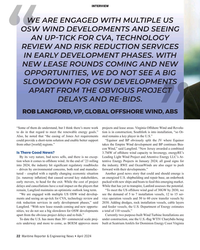 )
April 2024 - Maritime Reporter and Engineering News page: 22
)
April 2024 - Maritime Reporter and Engineering News page: 22DELAYS AND RE-BIDS. ROB LANGFORD, VP, GLOBAL OFFSHORE WIND, ABS “Some of them do understand, but I think there’s more work projects and lease areas. Virginia Offshore Wind and Revolu- to do in that regard to meet the renewable energy goals.” tion is in construction; Southfork is into installation, “so
-
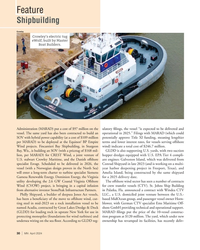 )
April 2024 - Marine News page: 30
)
April 2024 - Marine News page: 30a long-term charter to turbine specialist Siemens Amelia Island, being constructed by the same shipyard Gamesa Renewable Energy. Dominion Energy, the Virginia for a 2025 delivery date. utility developing the 2.6 GW Coastal Virginia Offshore The offshore wind sector has seen a number of contracts Wind
-
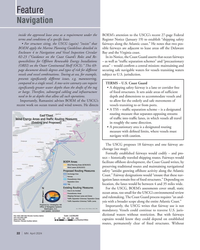 )
April 2024 - Marine News page: 22
)
April 2024 - Marine News page: 22Guidelines detailed in sible fairways are adjacent to lease areas off the Delaware Enclosure 4 to Navigation and Vessel Inspection Circular Bay and the Virginia coast. 02-23 (“Guidance on the Coast Guard’s Roles and Re- In its Notice, the Coast Guard asserts that ocean fairways sponsibilities for Offshore
-
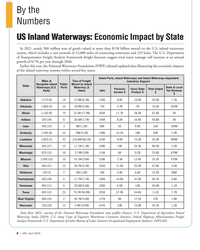 )
April 2024 - Marine News page: 8
)
April 2024 - Marine News page: 8260 (28)617.7M (7.7B)184K14.8B31.9B65.7B4.8B Tennessee 950 (11)529.5M (5.6B)100K6.5B12B26.4B1.1B Texas 830 (13)2379.7M (54.9B)305K27.9B54.6B111B7.7B West Virginia 680 (16)245.7M (3.4B)127K8B17.1B37B1.8B Wisconsin 230 (29)121.9M (107M)147K10B15.8B34.1B1.2B Data from 2021, courtesy of the National Waterways Foundation
-
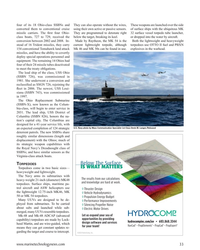 )
January 2024 - Marine Technology Reporter page: 33
)
January 2024 - Marine Technology Reporter page: 33with the Ohios; much of its strategic weapon capabilities with the Royal Navy’s Dreadnought class of SSBNs; and have similar sensors as the Virginia-class attack boats. Below The Surface TORPEDOES IS WHAT MATTERS Torpedoes come in two basic sizes— heavyweight and lightweight. The Navy arms its
-
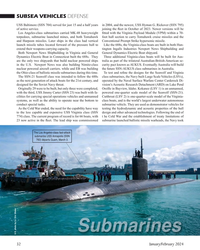 )
January 2024 - Marine Technology Reporter page: 32
)
January 2024 - Marine Technology Reporter page: 32of active service. joining the ? eet in October of 2023. Newer versions will be Los Angeles-class submarines carried MK-48 heavyweight ? tted with the Virginia Payload Module (VPM) within a 70- torpedoes, submarine launched mines, and both Tomahawk foot hull section to carry Tomahawk cruise missiles and
-
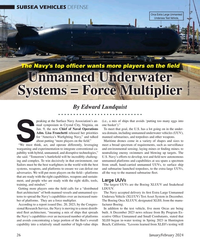 )
January 2024 - Marine Technology Reporter page: 26
)
January 2024 - Marine Technology Reporter page: 26Lundquist peaking at the Surface Navy Association’s an- (i.e., a mix of ships that avoids ‘putting too many eggs into nual symposium in Crystal City, Virginia, on one basket’).” Jan. 9, the new Chief of Naval Operations To meet that goal, the U.S. has a lot going on in the under- Adm. Lisa Franchetti released
-
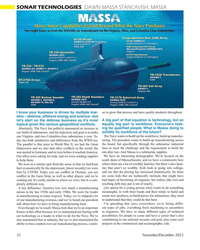 )
November 2023 - Marine Technology Reporter page: 32
)
November 2023 - Marine Technology Reporter page: 32The Navy has publicly announced an increase in solidify its workforce of the future? our build of submarines, and the trajectory and goal is to make one Virginia- and two Columbia-class submarines a year. To- The Navy wants to build up the workforce, build up manufac- day has both similarities and differences
-
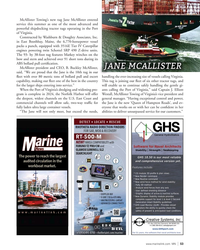 )
November 2023 - Marine News page: 53
)
November 2023 - Marine News page: 53Towing’s new tug Jane McAllister entered service this summer as one of the most advanced and powerful shipdocking tractor tugs operating in the Port of Virginia. Constructed by Washburn & Doughty Associates, Inc. in East Boothbay, Maine, the 6,770-horsepower vessel packs a punch, equipped with 3516E Tier
-
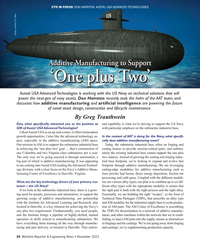 )
November 2023 - Maritime Reporter and Engineering News page: 24
)
November 2023 - Maritime Reporter and Engineering News page: 24and in achieving the ‘one plus two’ goal … that’s construction of casting houses to provide mission-critical parts, and unfortu- one Columbia and two Virginia class submarines per a year. nately the existing industrial base cannot support the one plus The only way we’re going succeed is through automation
-
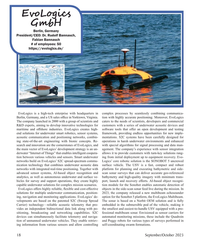 )
September 2023 - Marine Technology Reporter page: 18
)
September 2023 - Marine Technology Reporter page: 18is a high-tech enterprise with headquarters in complex processes by seamlessly combining communica- Berlin, Germany, and a US sales of? ce in Yorktown, Virginia. tion with highly accurate positioning. Moreover, EvoLogics The company launched in 2000 with a group of scientists and caters to the needs of
-
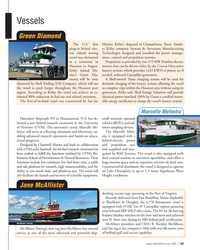 )
October 2023 - Marine News page: 43
)
October 2023 - Marine News page: 43Wave also facilitate the launch and recovery of scienti? c equipment, Height conditions. Jane McAllister docking tractor tugs operating in the Port of Virginia. Recently delivered from East Boothbay, Maine shipbuild- er Washburn & Doughty, the 6,770 horsepower vessel is equipped with 3516E Tier IV Caterpillar
-
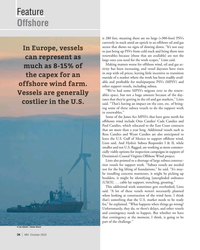 )
October 2023 - Marine News page: 34
)
October 2023 - Marine News page: 34I & II, while smaller and not U.S. ? agged, are working as more commer- cially viable options for inspection campaigns in support of Dominion’s Coastal Virginia Offshore Wind project. Lints also pointed to a shortage of large subsea construc- tion vessels for support work. “Subsea vessels are needed not for
-
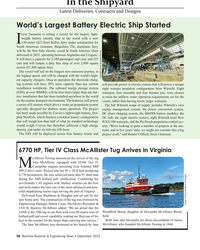 )
September 2023 - Maritime Reporter and Engineering News page: 58
)
September 2023 - Maritime Reporter and Engineering News page: 58will be deployed across four battery rooms and project at all,” said Robert Clifford, Incat Chairman. 6770 HP, Tier IV Class McAllister Tug Arrives in Virginia cAllister Towing announced the arrival of the tug Jane McAllister, equipped with 3516E Tier IV M Caterpillar engines powering twin Schottel SRP
-
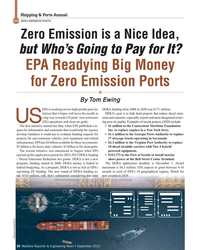 )
September 2023 - Maritime Reporter and Engineering News page: 38
)
September 2023 - Maritime Reporter and Engineering News page: 38and related 37 drayage trucks operating in Savannah. infrastructure. EPA has $4 billion available for these investments: • $2.3 million to the Virginia Port Authority to replace $1 billion is for heavy duty vehicles; $3 billion is for clean ports. 10 diesel straddle carriers with Tier 4 hybrid
-
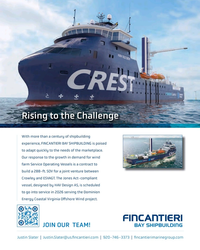 )
August 2023 - Maritime Reporter and Engineering News page: 3
)
August 2023 - Maritime Reporter and Engineering News page: 3and ESVAGT. The Jones Act-compliant vessel, designed by HAV Design AS, is scheduled to go into service in 2026 serving the Dominion Energy Coastal Virginia O?shore Wind project. JOIN OUR TEAM! Justin Slater | Justin.Slater@us.?ncantieri.com | 920-746-3373 | ?ncantierimarinegroup.com MR #8 (1-17)
-
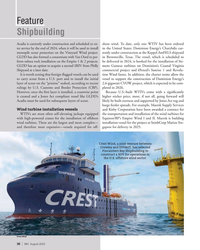 )
August 2023 - Marine News page: 38
)
August 2023 - Marine News page: 38in 2024, is booked for the installation of Sie- GLDD has an option to acquire a second SRIV from Philly mens Gamesa turbines on Dominion’s Coastal Virginia Shipyard at a later date. commercial project and Ørsted’s Sunrise 1 and Revolu- It is worth noting that foreign-? agged vessels can be used tion
-
 )
May 2023 - Marine Technology Reporter page: 7
)
May 2023 - Marine Technology Reporter page: 7, and Head of Communications for Konowe studies degree at Dalhousie University in Seabed 2030. For almost a decade, she’s Celia Konowe is from Reston, Virginia, Halifax, Nova Scotia. been telling stories about humankind’s recently graduating from the University of relationship with the ocean. Tomic Rochester
-
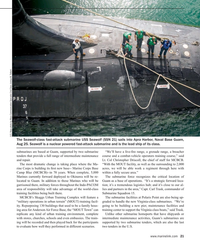 )
May 2023 - Maritime Reporter and Engineering News page: 21
)
May 2023 - Maritime Reporter and Engineering News page: 21a The submarine facilities at Polaris Point are also being up- “military operations in urban terrain” (MOUT) training facil- graded to handle the new Virginia-class submarines. “We’re ity. Repurposing 130 buildings that used to be a family hous- going to be building a new pier, maintenance facilities and
-
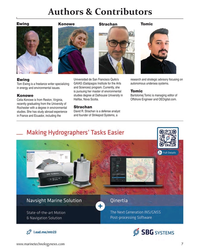 )
March 2023 - Marine Technology Reporter page: 7
)
March 2023 - Marine Technology Reporter page: 7University in Bartolomej Tomic is managing editor of Konowe Halifax, Nova Scotia. Offshore Engineer and OEDigital.com. Celia Konowe is from Reston, Virginia, recently graduating from the University of Strachan Rochester with a degree in environmental David R. Strachan is a defense analyst studies
-
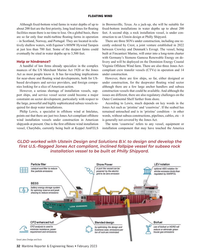 )
February 2023 - Maritime Reporter and Engineering News page: 32
)
February 2023 - Maritime Reporter and Engineering News page: 32Energy on de- Help or hindrance? livery and will be deployed on the Dominion Energy Coastal A handful of law ? rms already specialize in the complex Virginia Offshore Wind farm. There are also three Jones Act- nuances of the US Merchant Marine Act 1920 or the Jones compliant crew transfer vessels (CTVs)
-
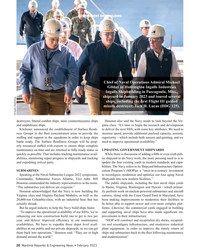 )
February 2023 - Maritime Reporter and Engineering News page: 20
)
February 2023 - Maritime Reporter and Engineering News page: 20industry representatives in the room. The public shipyards, including the four naval ships yards “The submarines you deliver are exquisite.” in Maine, Virginia, Washington and Hawaii—which primar- Houston acknowledged that the Navy is now building the ily perform work on nuclear-powered submarines and aircraft
-
 )
February 2023 - Maritime Reporter and Engineering News page: 18
)
February 2023 - Maritime Reporter and Engineering News page: 18close to that goal requires more ers, as well as the two-per-year desired production rate for than demand, and even more than money. For one thing, it Virginia-class submarines. “I know that there are constraints requires an industrial base that can build, repair and sustain with respect to the workforce
-
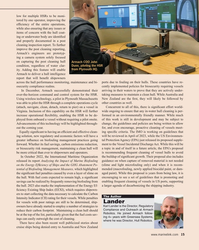 )
February 2023 - Maritime Reporter and Engineering News page: 15
)
February 2023 - Maritime Reporter and Engineering News page: 15other countries as well. (attach, navigate, clean, detach, return to pier) on a vessel in Concurrent to all of this, there is signi? cant effort world- Virginia. Inclusion of this capability on the HSR will further wide ongoing to ensure that any in-water hull cleaning is per- increase operational ? exibility
